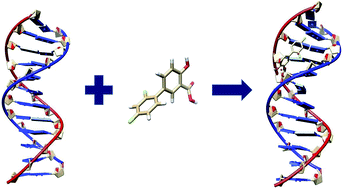Spectroscopic and molecular docking evidence of aspirin and diflunisal binding to DNA: a comparative study
Abstract
Aspirin and diflunisal belong to the salicylate class of non-steroidal anti-inflammatory drugs with diverse pharmacological and biological activities. Deciphering the interaction of drugs with DNA not only offers insights for the rational design of novel and more efficient drugs targeted to DNA, but also gives an opportunity for developing effective therapeutic agents for the control of gene expression. A series of spectroscopic studies were performed to ascertain the binding mode of aspirin and diflunisal with calf thymus DNA. UV-visible spectroscopy confirmed aspirin and diflunisal interaction with DNA. Steady state fluorescence experiments revealed a binding constant of 2.3 × 104 L mol−1 for aspirin and 7.9 × 103 L mol−1 for diflunisal. In addition, their binding modes with calf thymus DNA were established by a series of experiments including competitive displacement assays, urea denaturation, iodide quenching, viscosity measurements, DNA melting studies and CD analysis. They corroborated the intercalative binding of aspirin and groove binding of diflunisal with calf thymus DNA. The effect of ionic strength established the role of electrostatic interaction in aspirin–DNA binding processes. Molecular docking studies further complemented the experimental results.


 Please wait while we load your content...
Please wait while we load your content...